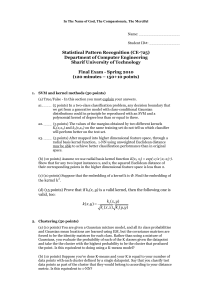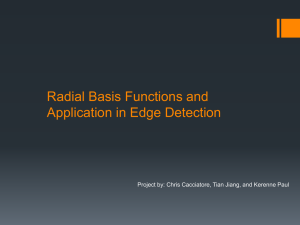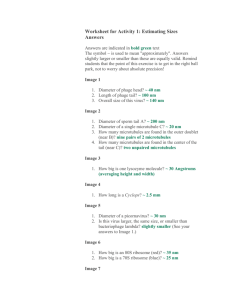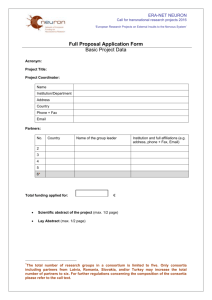ECE/CS/ME 539 Introduction to Artificial Neural Networks and Fuzzy
advertisement
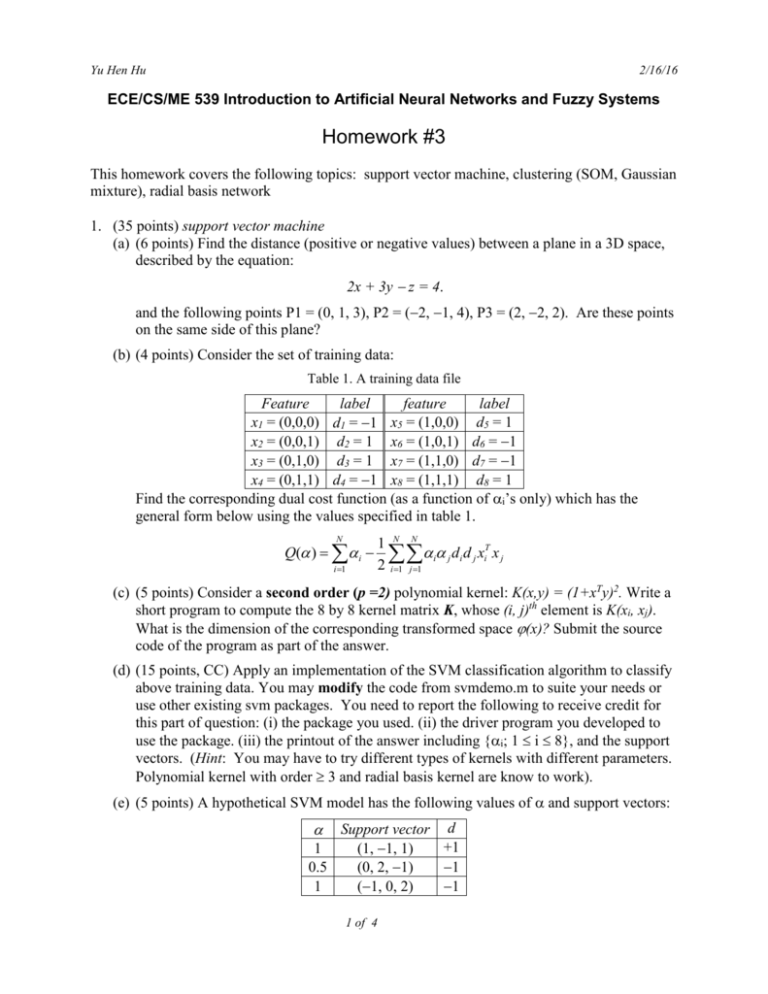
Yu Hen Hu
2/16/16
ECE/CS/ME 539 Introduction to Artificial Neural Networks and Fuzzy Systems
Homework #3
This homework covers the following topics: support vector machine, clustering (SOM, Gaussian
mixture), radial basis network
1. (35 points) support vector machine
(a) (6 points) Find the distance (positive or negative values) between a plane in a 3D space,
described by the equation:
2x + 3y z = 4.
and the following points P1 = (0, 1, 3), P2 = (2, 1, 4), P3 = (2, 2, 2). Are these points
on the same side of this plane?
(b) (4 points) Consider the set of training data:
Table 1. A training data file
Feature
label
feature
label
x1 = (0,0,0) d1 = 1 x5 = (1,0,0) d5 = 1
x2 = (0,0,1) d2 = 1 x6 = (1,0,1) d6 = 1
x3 = (0,1,0) d3 = 1 x7 = (1,1,0) d7 = 1
x4 = (0,1,1) d4 = 1 x8 = (1,1,1) d8 = 1
Find the corresponding dual cost function (as a function of i’s only) which has the
general form below using the values specified in table 1.
N
Q( ) i
i 1
1 N N
i j di d j xiT x j
2 i 1 j 1
(c) (5 points) Consider a second order (p =2) polynomial kernel: K(x,y) = (1+xTy)2. Write a
short program to compute the 8 by 8 kernel matrix K, whose (i, j)th element is K(xi, xj).
What is the dimension of the corresponding transformed space (x)? Submit the source
code of the program as part of the answer.
(d) (15 points, CC) Apply an implementation of the SVM classification algorithm to classify
above training data. You may modify the code from svmdemo.m to suite your needs or
use other existing svm packages. You need to report the following to receive credit for
this part of question: (i) the package you used. (ii) the driver program you developed to
use the package. (iii) the printout of the answer including {i; 1 i 8}, and the support
vectors. (Hint: You may have to try different types of kernels with different parameters.
Polynomial kernel with order 3 and radial basis kernel are know to work).
(e) (5 points) A hypothetical SVM model has the following values of and support vectors:
Support vector d
+1
1
(1, 1, 1)
0.5
(0, 2, 1)
1
1
(1, 0, 2)
1
1 of 4
Yu Hen Hu
2/16/16
Suppose that the linear kernel is used. Compute the output of this SVM model when the
input feature vector is (0.3, 0.8, 0.6).
2.
(30 points) Kmeans clustering algorithm
(a) (5 points) Given a set of cluster centers {wi; 1 i c}. The data points x will be assigned
to a cluster center wi if d(wi, x) = ||wi x|| is minimum among all other cluster centers.
This assignment will partition the feature space into c voronoi regions {Vi; 1 i c}
such that Vi = {x| ||wi x|| ||wk x||, k i}. In a 2D feature space, if the cluster centers
are located at {(1, 0), (1, 1), (2, 3)}, draw these points and the boundary of
corresponding voronoi regions within rectangular area having lower-left corner point (2,
4) and upper-right corner point (3, 4).
(b) (4 points) In the maximization step of the kmeans algorithm, we find new position of the
cluster center, given a set of data points {xi} that are assigned to the same cluster. Define
the within-cluster distortion as
Ni
D ( xi w) 2
i 1
Find an expression of w that will minimize D. Show your derivation.
(c) (6 points) To apply the kmeans algorithm, the number of the cluster center must be
specified. One criterion is to use the within-cluster scatter matrix SW and between-cluster
scatter matrix SB as defined in the class notes. Based on the definition of these matrices,
derive the following equations:
a. m
1
N
c
N m
i 1
i
i
b. ST = SB + SW .
Provide necessary details of your derivation.
(d) (10 points, CC) Download data files hw2p2a.txt and hw2p2b.txt. Use kmeans
clustering algorithm to cluster these data points. Use 2, 4 and 10 clusters for each data
file. Plot the resulting clustering centers and voronoi regions similar to that shown in
clusterdemo.m. You may copy and modify clusterdemo.m to solve this problem.
(e) (5 points) Consider the clustering of the following eight points (1.5, 0), (0.5, 0), (0.5,
0), (1.5, 0), (1.5, 1.8), (0.5, 1.8), (0.5, 1.8), (1.5, 1.8) into two clusters. There are two
possible choices of clustering centers:
Choice 1. (0, 0), and (0, 1.8)
Choice 2. (1, 0.9), and (1, 0.9)
Which of these two choices has smaller distortion? (assume Eucledean distance measure
is used. Run keams clustering algorithm on these data samples and verify your answer.
3. (10 points,CC) Self Organizing Map
Download data file hw2p3.txt. It contains 20 points within a square bounded by (0, 0) and
(1, 1). Use a 1D array of 20 neurons, each labeled with a number 1 to 20.
2 of 4
Yu Hen Hu
2/16/16
(a) (5 points, CC) Develop a SOM clustering program (you may modify from somdemo.m)
using 10 neurons arranged in a linear array with each neuron labeled with 1 to 10.
Submit a copy of your program and a figure similar to that given in somdemo.m.
(b) (5 points, CC) Manually or using a program to assign each of the 20 points to a neuron
(cluster center). Denote nc to be a 1 by 10 array such that nc(i) = number of data points
assigned to i-th neuron. Measure the 2D distance between successive neurons. Assign
the first neuron with a coordinate of 0 in a 1-D number line. The coordinate of 2nd neuron
equals to the distance from it to the first neuron. The coordinate of the 3rd neuron equal to
the coordinate of the 2nd neuron plus the 2D distance from the 2nd neuron to the 3rd
neuron, and so on. Draw a bar graph of nc versue each neuron’s 1D coordinate just
computed. This bar graph can be regarded as a 1D histogram approximating the 2D
distribution of the given data points. Submit materials highlighted in bold face words.
4. (25 points) radial basis network
A radial basis function can be represented as:
N
F ( x) wi (|| x xi ||)
i 1
where (r) is the radial basis function. Three examples of (r) are:
r 2 c 2 , c > 0,
(i)
Multiquadrics: m(r) =
(ii)
Inverse multquadrics: i(r) = 1 / r 2 c 2 , c > 0, and
(iii)
Gaussian: g(r) = exp{r 2 /( 2 2 )} , > 0,
Suppose that there are four pairs of training samples:
{(xi, di); 1 i 4} = {(2, 1), (1, 1), (0, 1), (2, 0.5)}
Assume that c = = 1. By imposing the interpolation condition F(xi) = di, a linear system of
four equations
w = d
can be obtained where w = [w1, w2, w3, w4]T, and d = [1 1 1 0.5]T.
(a) (5 points) Derive the matrix and find its eigenvalues for each of the three radial basis
functions. Also, discuss your observations on these eigenvalues briefly.
(b) (5 points) For each of the radial basis functions listed above, find the weight vector w,
and plot the approximated function F(x) over the interval [3 4] at increment of 0.05.
(c) (15 points, CC) Down-load two files hw4p4r.txt (training file) and hw4p4t.txt (testing
file). Use the training file to develop a RBF network and use the testing file to test the
performance. Note the testing file can not be used during the development of the network.
Perform the following tasks:
(i) (5 points, CC) Develop a RBF type 1 network using Gaussian RBF with = 0.5.
Choose at least three values of regularization parameter so that the training data is
fitted best. Discuss how do you decide the fitting is good without using the testing
file. Submit a) the source code, b) the model parameters (weights) developed, c) a
table listing different values of and corresponding training errors. d) A plot of the
3 of 4
Yu Hen Hu
2/16/16
model that fitting with training data using different values of of your choice (at least
three should be shown). e) Another plot of fitting the model of your choice that fit the
testing data.
(ii) (5 points,CC) Develop a generalized RBF (type II) network using Gaussian RBF. Use
two different the number of cluster centers J (1 J 10). For each value of J, submit
a) compute the G matrix and the G0 matrix, and the weights. b) the corresponding
plots of the model fitting with the training data and the testing data.
(iii) (5 points, CC) For RBF type I network with a Gaussian RBF function, discuss
influence of different values of on the results in part (i). Submit a) a plot of fitting
training data using at least three different values of while = 0.1.
4 of 4

